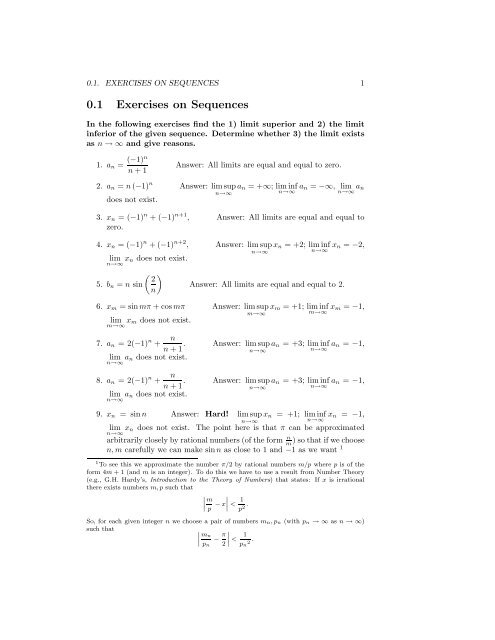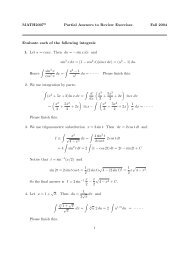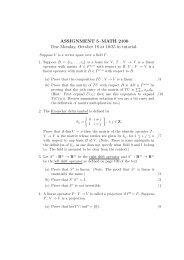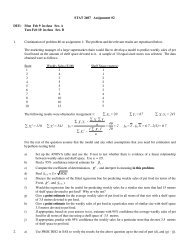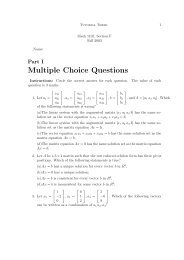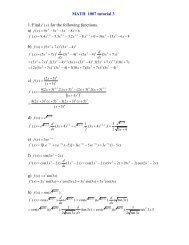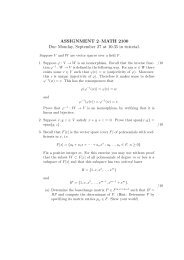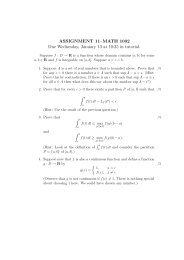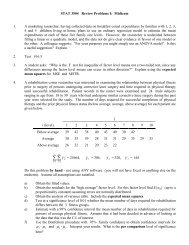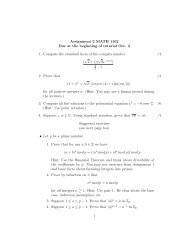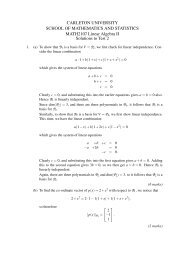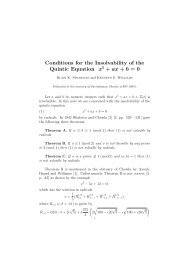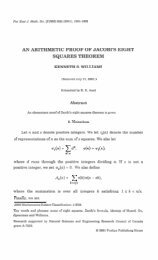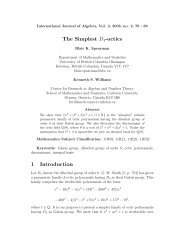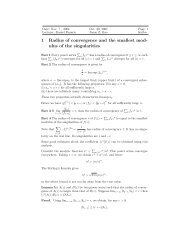0.1 Exercises on Sequences
0.1 Exercises on Sequences
0.1 Exercises on Sequences
You also want an ePaper? Increase the reach of your titles
YUMPU automatically turns print PDFs into web optimized ePapers that Google loves.
<str<strong>on</strong>g>0.1</str<strong>on</strong>g>. EXERCISES ON SEQUENCES 1<br />
<str<strong>on</strong>g>0.1</str<strong>on</strong>g> <str<strong>on</strong>g>Exercises</str<strong>on</strong>g> <strong>on</strong> <strong>Sequences</strong><br />
In the following exercises find the 1) limit superior and 2) the limit<br />
inferior of the given sequence. Determine whether 3) the limit exists<br />
as n →∞and give reas<strong>on</strong>s.<br />
1. an = (−1)n<br />
n +1<br />
2. an = n (−1) n<br />
does not exist.<br />
Answer: All limits are equal and equal to zero.<br />
Answer: lim sup an =+∞; lim inf<br />
n→∞<br />
n→∞ an = −∞, lim<br />
n→∞ an<br />
3. xn =(−1) n +(−1) n+1 , Answer: All limits are equal and equal to<br />
zero.<br />
4. xn =(−1) n +(−1) n+2 , Answer: lim sup<br />
lim<br />
n→∞<br />
n→∞<br />
xn does not exist.<br />
5. bn = n sin<br />
<br />
2<br />
n<br />
xn = +2; lim inf<br />
n→∞ xn = −2,<br />
Answer: All limits are equal and equal to 2.<br />
6. xm =sinmπ +cosmπ Answer: lim sup<br />
lim<br />
m→∞ xm does not exist.<br />
7. an =2(−1) n + n<br />
n +1<br />
m→∞<br />
xm = +1; lim inf<br />
m→∞ xm = −1,<br />
. Answer: lim sup an = +3; lim inf<br />
n→∞<br />
n→∞ an = −1,<br />
lim<br />
n→∞ an does not exist.<br />
8. an =2(−1) n + n<br />
n +1<br />
. Answer: lim sup an = +3; lim inf<br />
n→∞<br />
n→∞ an = −1,<br />
lim<br />
n→∞ an does not exist.<br />
9. xn = sinn Answer: Hard! lim sup xn = +1; lim inf<br />
n→∞<br />
n→∞ xn = −1,<br />
lim<br />
n→∞ xn does not exist. The point here is that π can be approximated<br />
arbitrarily closely by rati<strong>on</strong>al numbers (of the form n<br />
m ) so that if we choose<br />
n, m carefully we can make sin n as close to 1 and −1 aswewant1 1 To see this we approximate the number π/2 by rati<strong>on</strong>al numbers m/p where p is of the<br />
form 4m +1 (and m is an integer). To do this we have to use a result from Number Theory<br />
(e.g., G.H. Hardy’s, Introducti<strong>on</strong> to the Theory of Numbers) that states: If x is irrati<strong>on</strong>al<br />
there exists numbers m, p such that<br />
<br />
<br />
m<br />
<br />
<br />
− x<br />
<<br />
p 1<br />
.<br />
p2 So, for each given integer n we choose a pair of numbers mn,pn (with pn →∞as n →∞)<br />
such that <br />
mn<br />
−<br />
pn<br />
π<br />
<br />
<br />
<<br />
2<br />
1<br />
.<br />
pn<br />
2
2<br />
10. xn =2cosn Answer: Hard! lim sup<br />
lim<br />
n→∞ xn does not exist.<br />
n→∞<br />
11. xn =3xn−1 where n =1, 2, 3,... and x0 = −2.<br />
Answer: All the limits are equal to −∞.<br />
12. xn = −xn−1 where n =1, 2, 3,... and x0 = −1.<br />
xn = +2; lim inf<br />
n→∞ xn = −2,<br />
Answer: lim sup xn = +1; lim inf<br />
n→∞<br />
n→∞ xn = −1, lim<br />
n→∞ xn does not exist.<br />
Prove that the following sequences defined iteratively (or by recursi<strong>on</strong>)<br />
are Cauchy sequences and find their limits. Prove the existence<br />
of the limit using an ε argument.<br />
13. xn = xn−1 where n =1, 2, 3,... and x0 = A.<br />
Answer: The limit is A.<br />
14. xn = 1<br />
2 xn−1, wheren =1, 2, 3,... and x0 =1.<br />
Answer: The limit is zero.<br />
15. xn = 2<br />
5 xn−1 where n =1, 2, 3,... and x0 = −2.<br />
Answer: The limit is zero.<br />
Miscellaneous problems<br />
16. Prove that the sequence (also known as an arithmetic progressi<strong>on</strong>) defined<br />
iteratively by xn = a + xn−1, n ≥ 1, where a is a fixed real number, x0 is<br />
given, is a Cauchy sequence if and <strong>on</strong>ly if a =0.<br />
Answer: Note that |xn − xm| = |a||n − m| which can be made arbitrarily<br />
small if and <strong>on</strong>ly if a =0.<br />
17. Show that the sequence defined iteratively by xn = a · xn−1 where n =<br />
1, 2, 3,... and x0 is a given real number, has the following properties:<br />
• It c<strong>on</strong>verges to 0 if |a| < 1<br />
• It c<strong>on</strong>verges to x0 if a =1<br />
• It c<strong>on</strong>verges to 0 if a ∈ R and x0 =0<br />
• The limit does not exist if a = −1 andx0= 0<br />
• It c<strong>on</strong>verges to ∞ if a>1andx0 > 0<br />
From this we get <br />
mn πpn <br />
− <<br />
2<br />
1<br />
.<br />
pn<br />
We claim that the integers mn form a subsequence of the natural numbers such that<br />
sin mn → 1asn →∞. This is because sin mn =sin(mn + pnπ/2 +pnπ/2) = sin(mn −<br />
pnπ/2) cos(pnπ/2) + cos(mn − pnπ/2) sin(pnπ/2) = cos(mn − pnπ/2), since pn is of the form<br />
4m + 1. Now use the Mean Value Theorem: | sin mn − 1| = | cos(mn − pnπ/2) − cos 0| =<br />
| sin ξ||mn − pnπ/2| ≤|mn− pnπ/2| < 1/pn. The result follows up<strong>on</strong> letting n →∞. A<br />
similar argument is used for the lim inf result.
<str<strong>on</strong>g>0.1</str<strong>on</strong>g>. EXERCISES ON SEQUENCES 3<br />
• It c<strong>on</strong>verges to −∞ if a>1andx0 < 0<br />
• The limit does not exist if a ≤−1andx0= 0<br />
Answer: Show that xn = a n x0 for every n ≥ 1 after which all the results<br />
follow.<br />
18. Determine whether or not the sequence, xn defined for each integer n, by<br />
the finite series<br />
xn = arctan 1 + arctan 2 + arctan 3 + ...+arctann,<br />
for n ≥ 1, c<strong>on</strong>verges as n →∞!?<br />
Answer: No, the limit cannot exist since arctan n → π/2 asn →∞and<br />
so the Divergence Test for infinite series applies and this result follows.


